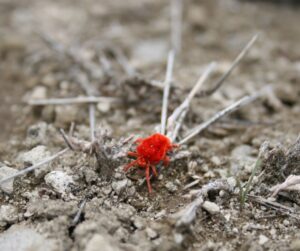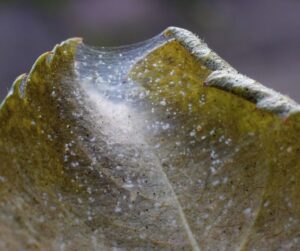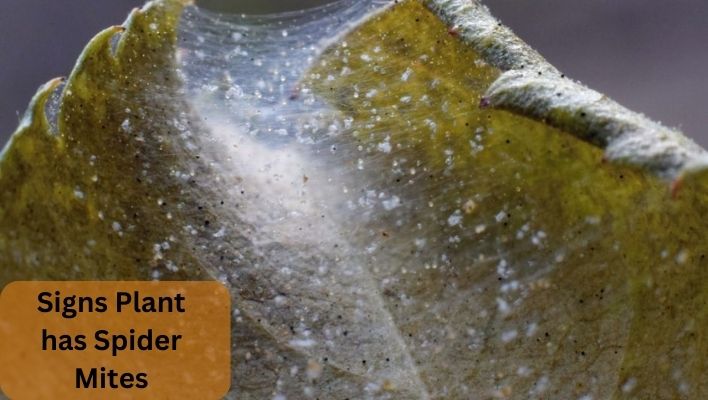Are your leafy companions feeling a bit off lately? Well, it could be the mischievous work of those tiny troublemakers known as spider mites, or could it be another reason? If you’re wondering how to tell if your plant is dealing with these pesky pests, you’ve come to the right place.
Below, we’ll uncover the telltale signs that a plant has spider mites and equip you with the knowledge to tackle these unwelcome guests head-on.
We all know how much effort goes into nurturing our green leafy companions. But what happens when these little wonders start showing signs of distress? One common culprit that can wreak havoc on our plants is none other than the notorious spider mite.
Now, you might be wondering why it’s so crucial to detect spider mite infestations at the earliest possible stage. Well, the answer is simple: early identification means early intervention.
By catching these sneaky mites in action, you can prevent them from causing severe damage to your beloved plants. We’re talking about keeping your green beauties healthy, vibrant, and thriving.
Don’t fret, though; In this article, we’ll arm you with all the knowledge you need to identify the signs of a spider mite infestation early on and tackle it head-on. So, let’s dive right in and learn how to outsmart these pesky pests. Grab your magnifying glass and get ready to become a spider mite detective
What are Spider Mites?
Spider mites, the minuscule members of the arachnid family, are notorious troublemakers in the plant world. These tiny pests measure a mere 0.5 millimeters in size, but their impact on plants can be significant. Don’t let their diminutive stature fool you; spider mites can cause major headaches for gardeners.
In appearance, spider mites can vary in color, ranging from red and green to brown or yellow. These translucent creatures are equipped with eight legs, just like their larger spider relatives.
Despite their name, they aren’t actual spiders, but their behavior is certainly reminiscent of their arachnid counterparts.

Spider mites are formidable reproducers, laying countless eggs on the underside of plant leaves. They thrive in warm and dry conditions, making them particularly troublesome during hot summer months.
These sneaky critters are relentless in their quest for sustenance, piercing plant tissues and sucking out vital fluids. Their feeding frenzy weakens the plants, leaving behind a trail of damage that can stunt growth and hinder photosynthesis.
Now that we’ve familiarized ourselves with these miniature garden intruders, let’s move on to the next crucial section: identifying the signs that indicate a plant has fallen prey to spider mites.

Signs of a spider mite infestation
Spotting a spider mite infestation early on is key to preventing severe damage to your plants. Keep an eye out for the following telltale signs that indicate these tiny troublemakers have set up camp on your beloved greenery:
- Visible Webbing: Spider mites are skilled weavers, and their delicate webbing can be spotted on leaves, stems, and the spaces between them. These fine threads may resemble tiny cobwebs and are often most noticeable on the undersides of leaves.
- Tiny Specks: Take a closer look at the surface of your plant leaves and stems. If you observe tiny specks, resembling grains of sand or dust, these are likely spider mites themselves or their eggs. These specks can range in color, from translucent to red or black, depending on the species.
- Discoloration and Stippling: Spider mites are voracious sap-suckers, leaving behind a trail of damage. Look for signs of yellowing, bronzing, or browning on the leaves. Additionally, you may notice small dots or stippling on the leaf surface caused by their feeding activity.
- Distorted or Stunted Growth: Spider mites can disrupt the normal growth of plants. Keep an eye out for leaves that appear misshapen, curled, or distorted. In severe infestations, the overall growth of the plant may become stunted.
- White or Yellow Spots: Another sign of a spider mite infestation is the presence of white or yellow spots on the leaves. These spots often indicate areas where the mites have punctured the leaf tissues and extracted the vital plant fluids.
- Leaf Drop: If you notice an excessive amount of leaves dropping from your plant, it could be a result of a severe spider mite infestation. The stress caused by their feeding can lead to leaf loss.
- Silvery Appearance: Some plant species may exhibit a silvery or metallic sheen on the surface of the leaves due to spider mite feeding. This can be a distinct visual clue to their presence.
- Presence of Exoskeletons: As spider mites grow and molt, they leave behind their old exoskeletons. Look closely at the affected leaves, and you may spot these tiny exoskeletons, which can appear like translucent shells.
- Increased Pest Activity: Spider mites can attract other pests, such as ants or predatory insects, to your plants. If you notice an unusual influx of these creatures, it could be an indirect indication of a spider mite infestation.
- Plant Weakness: Over time, spider mite infestations can weaken plants, making them more susceptible to other diseases and stress factors. If you observe a general decline in the overall health and vigor of your plants, spider mites could be the underlying cause.
Being able to identify these signs promptly will empower you to take swift action against these unwanted guests. Now that you’re equipped with this knowledge, let’s explore how spider mites can impact your plants and what you can do about it.

How Spider Mites Affect Plants
Spider mites may be small, but their impact on plants can be significant. Here’s a closer look at how these pesky pests wreak havoc on your greenery:
- Feeding on Plant Fluids: Spider mites have needle-like mouthparts that they use to pierce plant tissues and feed on the sap or plant fluids within. As they extract these vital fluids, they weaken the plant and deprive it of essential nutrients.
- Damage to Plant Tissues: The feeding activity of spider mites leaves behind visible damage. As they puncture the plant cells, they cause physical injury to the leaves and stems. This damage can manifest as yellowing, browning, or bronzing of the foliage, leading to an overall decline in the plant’s appearance.
- Weakened Plants: With continued feeding, spider mites can severely weaken plants. As the plant becomes depleted of nutrients and energy, it becomes more susceptible to other stresses, such as drought, disease, and extreme temperatures. This weakened state compromises the overall health and vigor of the plant.
- Reduced Photosynthesis: Spider mite infestations can hinder the process of photosynthesis, which is crucial for plants to produce energy. The damage inflicted by their feeding disrupts the plant’s ability to harness sunlight and convert it into usable energy. This reduction in photosynthetic activity further weakens the plant and hampers its growth and development.
- Infestation Spread: Spider mites are known for their ability to quickly multiply and spread. They produce vast numbers of eggs, and as the infestation progresses, the population grows rapidly. They can easily disperse to nearby plants through wind, movement, or contact, leading to widespread infestation in your garden or indoor space.
Understanding how spider mites affect plants highlights the urgency of detecting and addressing infestations promptly.
Where do spider mites come from?
Spider mites can find their way into your garden or indoor space through various sources. Here are some common origins of spider mite infestations:
- Outdoor Plants: If you have outdoor plants in your garden or balcony, they can serve as a gateway for spider mites to enter your environment. These pests can hitch a ride on the leaves or stems of infested plants brought from nurseries, garden centers, or even other gardens.
- New Plant Acquisitions: Introducing new plants to your indoor or outdoor collection can unknowingly introduce spider mites. Even seemingly healthy plants can harbor hidden infestations. Therefore, it’s essential to inspect and quarantine new plant acquisitions before integrating them with your existing plants.
- Warm and Dry Conditions: Spider mites thrive in warm and dry environments. High temperatures and low humidity provide optimal conditions for their reproduction and survival. Indoor spaces with inadequate humidity control, such as heated homes during winter or arid climates, can create an inviting habitat for spider mites to thrive.
- Weeds and Wild Vegetation: Spider mites can also inhabit weeds and wild vegetation close to your garden. These plants can serve as reservoirs for spider mites, allowing them to easily migrate to your cultivated plants.
By being mindful of these sources, you can take preventive measures to minimize the risk of spider mite infestations.

How to prevent spider mite infestations
Prevention is always better than dealing with a full-blown infestation. By implementing these proactive measures, you can reduce the risk of spider mites wreaking havoc on your plants:
- Regular Inspections: Make it a habit to inspect your plants regularly, especially the undersides of leaves where spider mites tend to hide. Look for any signs of webbing, specks, discoloration, or distorted growth. Early detection allows for swift intervention.
- Plant Maintenance: Maintain plant health by providing them with optimal growing conditions. Ensure proper watering, adequate sunlight, and appropriate fertilization. Healthy plants are less susceptible to spider mite attacks.
- Humidity Control: Spider mites thrive in dry environments, so maintaining sufficient humidity levels can be an effective deterrent. Consider using a humidifier or employing methods like misting to increase humidity around your plants.
- Quarantine New Plants: Before introducing new plants to your existing collection, isolate them for a few weeks in a separate area. This quarantine period allows you to closely monitor the plants for any signs of spider mites or other pests. It helps prevent potential infestations from spreading to your other plants.
- Proper Plant Spacing: Avoid overcrowding your plants. Proper spacing allows for better air circulation and reduces the chances of spider mites easily moving from one plant to another.
- Natural Predators: Encourage beneficial insects like ladybugs, predatory mites, or lacewings, which feed on spider mites, to make your garden their home. These natural predators can help keep spider mite populations in check.
- Water Management: Spider mites thrive in dry conditions, so it’s important to avoid overwatering your plants. Excess moisture can promote fungal growth, which can attract spider mites. Ensure proper drainage and allow the soil to dry out between waterings.
- Companion Planting: Some plants act as natural repellents to spider mites. Consider incorporating companion plants such as marigolds, chrysanthemums, or garlic around your susceptible plants. These companion plants emit odors or compounds that deter spider mites.
- Cleanliness and Pruning: Regularly clean and remove any fallen leaves or debris from around your plants. Spider mites can hide and thrive in plant debris. Additionally, pruning infested plant parts can help control and minimize the spread of spider mites.
By implementing these preventive measures, you can create an inhospitable environment for spider mites and safeguard your precious plants.
However, in case prevention falls short and an infestation occurs, don’t worry—we’ll explore effective methods to tackle spider mites in the next section.

How to get rid of spider mites
If preventive measures have failed, and you find yourself facing a spider mite infestation, fear not. There are several effective methods to control and eliminate these pesky pests:
- Water Spray: A strong blast of water can dislodge spider mites from the plant leaves. Use a hose or a spray bottle to thoroughly spray the affected plants, focusing on the undersides of leaves where the mites tend to hide. Repeat this process regularly to disrupt their life cycle.
- Neem Oil: Neem oil is a natural insecticide derived from the neem tree. Dilute neem oil according to the instructions and spray it onto the infested plants. Neem oil disrupts the feeding and reproductive cycle of spider mites, helping to control their population.
- Insecticidal Soaps: Insecticidal soaps, available at garden centers, can be effective in controlling spider mites. These soaps work by suffocating and dehydrating the pests. Follow the instructions on the product label for application and safety guidelines.
- Horticultural Oils: Horticultural oils, such as mineral oil or dormant oil, can smother spider mites and their eggs. Dilute the oil as directed and apply it to the affected plants, ensuring thorough coverage of both the upper and lower leaf surfaces.
- Biological Control: Introduce natural predators of spider mites, such as predatory mites or ladybugs, into your garden. These beneficial insects feed on spider mites and can help keep their populations in check.
- Alcohol Solution: A simple homemade remedy is an alcohol solution. Mix rubbing alcohol or isopropyl alcohol with water in a spray bottle and apply it directly to the affected plants. The alcohol helps kill the spider mites on contact. Test the solution on a small area of the plant first to ensure it does not cause damage.
- Pruning and Disposal: If the infestation is localized to specific parts of the plant, carefully prune and remove the affected leaves or branches. Dispose of the infested plant material properly, away from your other plants, to prevent the spread of spider mites.
- Chemical Insecticides: As a last resort, if the infestation is severe and other methods have proven ineffective, chemical insecticides specifically labeled for spider mite control can be used. Follow the instructions carefully, and use these products judiciously and responsibly.
- Predatory Insects: Besides ladybugs, other predatory insects like predatory mites, lacewings, and minute pirate bugs can also be effective in controlling spider mite populations. You can purchase these beneficial insects from garden centers and release them in your garden or greenhouse.
- Sticky Traps: Place sticky traps around your plants to catch adult spider mites. These traps are coated with a sticky substance that traps the pests when they come into contact with it. Regularly check and replace the traps as needed.
- Companion Planting: Planting certain herbs and flowers known for their repellent properties can help deter spider mites. Examples include peppermint, spearmint, coriander, and calendula. Interplanting these with susceptible plants can create a less favorable environment for spider mites.
Remember to closely monitor the treated plants and repeat the chosen method as necessary to ensure complete eradication of the infestation.
It’s also important to continue implementing preventive measures to minimize the risk of future spider mite outbreaks.
By combining these control methods with preventive practices, you can successfully combat spider mites and restore the health and vitality of your plants. Now you’re equipped with the knowledge to tackle these tiny pests with confidence.
Conclusion
Dealing with spider mite infestations can be a frustrating experience for any plant lover. However, armed with the knowledge of the signs, prevention methods, and effective control measures, you can confidently tackle these tiny pests and protect your plants.
By promptly identifying the signs of spider mite infestations, such as webbing, yellowing leaves, stippling, and leaf discoloration, you can take early action to prevent the situation from worsening.
Implementing preventive measures like regular inspections, maintaining plant health, controlling humidity levels, and practicing proper plant spacing can significantly reduce the risk of spider mite infestations.
Should an infestation occur, a variety of methods are available to help you get rid of spider mites. From water sprays and organic remedies like neem oil and insecticidal soaps to introducing natural predators and utilizing chemical treatments as a last resort, there are options to suit different preferences and infestation levels.
Remember to continue monitoring and repeating treatments as needed to ensure complete eradication. Additionally, maintaining good garden hygiene, practicing companion planting, and integrating various control methods as part of an Integrated Pest Management (IPM) approach will help prevent future spider mite outbreaks.
With persistence, vigilance, and a proactive approach, you can successfully combat spider mites and protect the health and beauty of your cherished plants.
So, roll up your sleeves, embrace the challenge, and reclaim your garden from these pesky intruders. Your thriving, spider-mite-free plants will be a testament to your dedication and green thumb.
